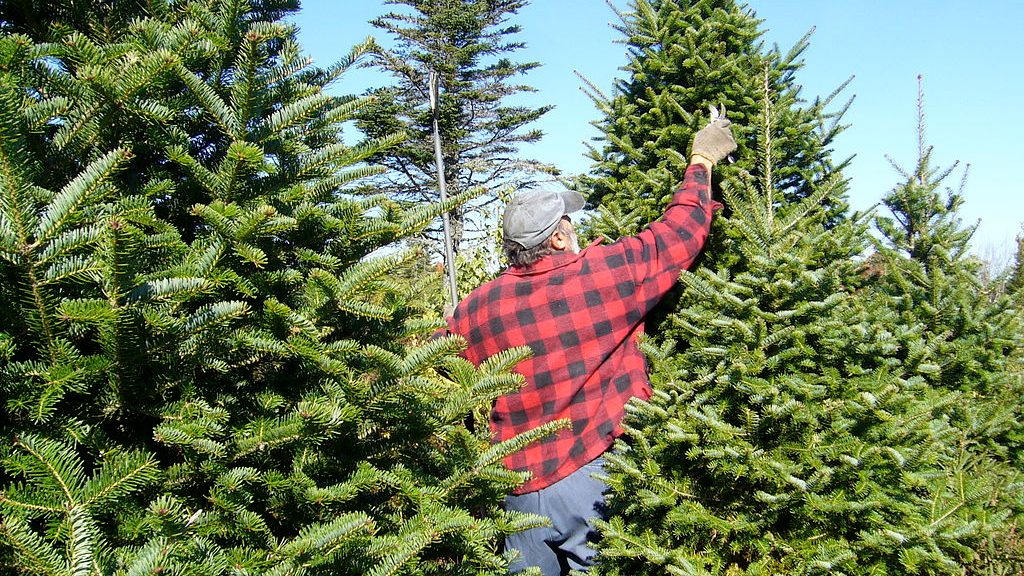
Fact Sheets And Publications

Pruning Evergreens
Revised in March 2025 | Written by: Jay Windsor Agricultural Agent, Revised by Susan Barton, Extension Specialist
Pruning is an important maintenance practice. Although necessary, pruning can be kept to a minimum by the wise use and proper placement of plant materials in the landscape.
Evergreen plants can be divided into two broad categories: (1) Narrowleaf (needled) evergreens such as pines, junipers, yews, and (2) Broadleaf evergreens like rhododendrons, hollies, boxwood. The narrowleaf evergreens are generally more rapid-growing, include many tree forms, and are commonly grown for their foliage only. Broadleaf evergreens are usually slower-growing, include many shrub forms, and are often grown for their flowers and fruit as well as for their foliage.
WHY PRUNE?
Limit the pruning of most evergreens to the removal of dead, diseased, and mechanically injured wood, and the maintenance of the natural shape of the plants. However, certain plants may be grown for special purposes, and may require special pruning. This would apply when formal effects are desired, such as clipped hedges, topiary, espaliers, etc. In addition, many evergreens are pruned during the Christmas season by homeowners who desire cut greens for holiday decorations.
WHEN TO PRUNE?
Dead, diseased, and broken wood can be removed at any time of year. However, for general pruning the best time is in late winter or early spring just before growth begins. Narrowleaf evergreens may be pruned a second time in June before the new growth has matured. It may be necessary to give particularly fast-growing plants an additional light pruning or two during the growing season. Good judgment must be exercised when pruning flowering evergreens, so as not to drastically reduce the amount of next season's flowering wood. Therefore prune as soon after flowering as possible. Severe pruning can usually be avoided if pruning is done annually.
HOW TO PRUNE?
It is important to have the necessary tools in proper working order for pruning your plants. These tools include a hand pruner, lopping shears, hedge shears, and a curved pruning saw (see Pruning Woody Plants for more detail about tools).
Narrowleaf evergreens are characterized by growth that is either whorled or random (non-whorled). When pruning pines, make cuts just above the needle whorls. Most new lateral growth is stimulated at these points, rather than along the stems between the whorls.
In pruning most other needled and broadleaf evergreens, cuts can be made at any point along the branch, but care should be taken not to cut too far back into the older wood. New growth is not as readily produced from old wood. When selectively pruning, always cut the growth back to a side shoot.
Some evergreen species withstand relatively heavy pruning. This is true of Japaneseyew, boxwood, andevergreen privet. These plants can be sheared, which involves the uniform removal of new growth to make a plant conform to a prescribed shape. Because shearing encourages the formation of additional lateral growth, a more dense habit of growth is created.
The amount and manner of pruning depend to a large extent on the type of plant, its location, and the particular tastes of the homeowner.
PRUNING POINTERS FOR SPECIFIC PLANTS
1. The PINE Group. Prune preferably in early spring. Make cuts just above needle whorls. Additional pruning may be done before new growth hardens in June. Pines normally require little pruning.
2. The SPRUCE and FIR Group. Cuts may be made at any point along the younger portions of the branches. The best time to prune these plants is in the early spring. Prune to maintain the natural shape of the plants.
3.. The JUNIPER, CHAMAECYPARIS, and ARBORVITAE Group. This group consists of many tree, shrub, and prostrate forms. These species can withstand relatively heavy pruning and many may be trained into various forms by shearing. Early spring pruning is best, but additional light pruning later in the season may be necessary.
4. The YEW and HEMLOCK Group. It is preferable to allow these plants to retain their natural form, but both respond well to heavy pruning and shearing. Yews are able to withstand exceptionally severe pruning into the older wood. Early spring is the best time for pruning but occasional light pruning later in the season may be necessary.
5. The RHODODENDRON, AZALEA, PIERIS, and MOUNTAIN LAUREL Group. These plants generally require very little pruning, as they are slow-growing. Old flower clusters should be removed immediately after flowering. Prune out only dead, diseased, weak or wayward branches.
6. The BOX, EVERGREEN PRIVET, BARBERRY, and PYRACANTHA Group. With the exception of box, these species grow rather rapidly. All these plants will stand heavy pruning. Early spring is a good time to prune them. Because they are generally quite vigorous, additional trimming during the growing season may be advisable.
7. The HOLLIES. These plants include both tree and shrub forms. American holly may be pruned in December for Christmas greens. Chinese holly is also a source of attractive greens and may be trimmed in the early spring. When pruning American holly, always make the cut at a node, just above a lateral bud. Prune so as to maintain the natural shape of the tree. The shrubby Chinese and Japanese hollies can be more severely pruned and may require some additional light pruning during the growing season.
8. The MAHONIA and LEUCOTHOE Group. These are rather slow-growing, and require little annual pruning, but if pruning is necessary, do it immediately after these plants flower in the spring.
Author
Jay Windsor Agricultural Agent,
Delaware Cooperative Extension, University of Delaware
Revised by Susan Barton, Extension Specialist 2025
HYG - 73
1/9/13
UD Cooperative Extension
This institution is an equal opportunity provider.
In accordance with Federal law and U.S. Department of Agriculture policy, Cooperative Extension is prohibited from discriminating on the basis of race, color, national origin, sex, age, or disability.
